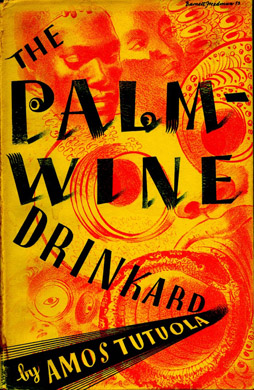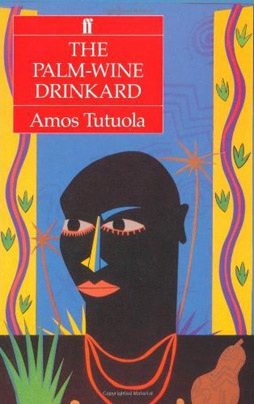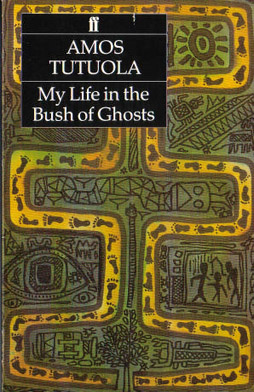Amos Tutuola, The Palm-Wine Drinkard, and My Life in the Bush of Ghosts
 Amos Tutuola was born in Nigeria in 1920 to a Christian family. With six years of formal schooling, he served as a coppersmith with the Lagos-based arm of the Royal Air Force in World War Two, then worked at a number of of odd jobs. As he tells it, a government magazine he happened to read, with “very lovely portraits of the gods,” advertised books based on Yoruba legends. Tutuola remembered being praised as a storyteller in school and decided there was no reason he shouldn’t turn his hand to writing similar books. So he did. He completed his first book, The Palm-Wine Drinkard, in only a few days.
Amos Tutuola was born in Nigeria in 1920 to a Christian family. With six years of formal schooling, he served as a coppersmith with the Lagos-based arm of the Royal Air Force in World War Two, then worked at a number of of odd jobs. As he tells it, a government magazine he happened to read, with “very lovely portraits of the gods,” advertised books based on Yoruba legends. Tutuola remembered being praised as a storyteller in school and decided there was no reason he shouldn’t turn his hand to writing similar books. So he did. He completed his first book, The Palm-Wine Drinkard, in only a few days.
It was a wild whirl of tales and motifs, inspired by West African oral storytelling traditions and The Arabian Nights. It was a kind of extended fable filled with magic and adventure, mixing myth and folktale in a seemingly endless procession of wonder. It was written in English, but a highly distinctive English — an informal, direct English, English as it suited Tutuola to write it.
Tutuoa didn’t do anything at first with the story, until he bought another magazine and saw an ad from the Lutheran World Press soliciting manuscripts. He sent them his work and got back a letter saying that the publisher only handled religious works, but that they were impressed with his story and would try to place it at another firm. After a year, Tutuola received a letter from British publishers Faber and Faber, asking about his novel. They published the book in 1952; it was well-reviewed, with especially glowing praise from Dylan Thomas, was translated into French, and generally established Tutuola as a powerful writer. He followed the first book with the equally fantastical My Life in the Bush of Ghosts in 1954, and went on to a long writing career before his death in 1997.
 Michael Swanwick’s written an excellent appreciation of Tutuloa and The Palm-Wine Drinkard here. He has no hesitation about describing Tutuloa as a fantasist and I tend to agree. It’s an assertion that raises the question of where the boundaries between myth, folktale, and fantasy can be found; I feel that The Palm-Wine Drinkard (and My Life in the Bush of Ghosts, which shares some minor characters with the first book) is the sort of work that shows us that there is no meaningful boundary between these things at all.
Michael Swanwick’s written an excellent appreciation of Tutuloa and The Palm-Wine Drinkard here. He has no hesitation about describing Tutuloa as a fantasist and I tend to agree. It’s an assertion that raises the question of where the boundaries between myth, folktale, and fantasy can be found; I feel that The Palm-Wine Drinkard (and My Life in the Bush of Ghosts, which shares some minor characters with the first book) is the sort of work that shows us that there is no meaningful boundary between these things at all.
These novels are Jack-stories, as per the useful definition of “Jack” in Clute and Grant’s Encyclopedia of Fantasy: “a wise fool, a trickster.” Perhaps it’s worth remembering that Jack heroes are common in folktale traditions, even if Tutuola’s first-person narrators feel a little more like everyman characters. So: the eponymous hero of The Palm-Wine Drinkard has to quest for the spirit of the tapster who drew palm-wine for him to drink, effectively raiding the underworld to try to return a dead soul to life, and encountering various marvels along the way. The hero of My Life in the Bush of Ghosts flees slavers as a young child and grows up in a supernatural wilderness filled with cities of horrific ghosts.
The second book’s more ghoulish than the first, and can be read more easily as a comment on the social situation of Africa and Nigeria; still, both are primarily fictions of wonder, where one fantastic image follows another. The overall plots are loose and episodic, allowing each event to occupy centre stage without necessarily setting up later events or leading to some immediate character growth. In fact, Tutuloa’s characters seem at least on the surface to be utterly flat, as with most folktale characters.
 His style is distinctive, and in fact controversial. On first publication of these stories, Western readers tended to assume that Tutuloa’s stories represented not only a highly original fantastical vision, but also a particularly African brand of English. African readers argued the opposite: much of Tutuloa’s motifs came from traditional stories, they said, while his language was not representative either of common West African speech or what educated West African writers were doing with the English language. In fact, Tutuloa’s work reads as naïve — ungrammatical, though never unclear, with simple sentence structures and loose paragraphing. It runs the risk, then, of playing into Western stereotypes of untutored African writing. (You can find a very good overview of this argument here, as part of a strong and measured consideration of Tutuloa’s approach.)
His style is distinctive, and in fact controversial. On first publication of these stories, Western readers tended to assume that Tutuloa’s stories represented not only a highly original fantastical vision, but also a particularly African brand of English. African readers argued the opposite: much of Tutuloa’s motifs came from traditional stories, they said, while his language was not representative either of common West African speech or what educated West African writers were doing with the English language. In fact, Tutuloa’s work reads as naïve — ungrammatical, though never unclear, with simple sentence structures and loose paragraphing. It runs the risk, then, of playing into Western stereotypes of untutored African writing. (You can find a very good overview of this argument here, as part of a strong and measured consideration of Tutuloa’s approach.)
I think Tutuola used the language that was at hand to find a way to tell his tales, as writers will, and I think his lack of formal education played a role in determining the linguistic resources available to him. But I also think what matters for any given writer is what they do with the resources they have. And, finally, I think Tutuloa found a kind of vernacular that allowed him to do what he wanted with the narrative material that interested him. His style works to get his tales across simply, directly, and above all quickly. Consider the following:
Then we started our journey in another bush, of course, it was full of Islands and swamps and the creatures of the Islands were very kind, because as soon as we reached there, they recieved us with kindness and gave us a lovely house in their town to live in. The name of the Island was called “Wraith-Island,” it was very high and it was entirely surrounded by water; all the people of the Island were very kind and they loved themselves, their work was only to plant their food, after that, they had no other work more than to play music and dance. They were the most beautiful creatures in the world of the curious creatures and also the most wonderful dancers and musicians, they were playing music and dancing throughout the day and night. But as the weather of the Island was suitable for us and when we saw that we should not leave there at once, we were dancing with them and doing as they were doing there. Whenever these Island creatures dress, you would be thinking they were human-beings and their children were performing always the stage plays. As we were living with them I became a farmer and planted many kinds of crops. But one day, as the crops had ripened enough there, I saw a terrible animal coming to the farm and eating the crops, but one morning I met him there, so I started to drive him away from the farm, of course I could not approach him as he was as big as an elephant. His fingernails were long to about two feet, his head was bigger than his body ten times. He had a large mouth which was full of long teeth, these teeth were about one foot long and as thick as a cow’s horns, his body was almost covered with black long hair like a horse’s tail hair. He was very dirty. There were five horns on his head and curved and levelled to the head, his four feet were as big as a log of wood. But as I could not go near him, I stoned him at a long distance, but before the stone could reach him, he had reached where I stood and got ready to fight me.
 That’s all one long paragraph in the original. You can see Tutuola’s way with language here, I think, and can see also how it helps build a rhythm and get his tale across. Firstly, the pace is incredible: the paragraph starts with him in one place, introduces a new setting and a new people and follows him as he settles down and then meets a monster — as well as setting up the conflict between the narrator and the monster, and ending on a cliffhanger. Then you can look at something like the run-on sentence that introduces the monster and see how Tutuola makes the rhythm of the language work for him. The clause “as the crops had ripened enough there” could probably do without the last “there” from purely grammatical perspective, but when he uses the word again a couple clauses later, there’s an effect almost like rhyme in poetry; it ties the sentence together, as does the repeated use of the word “crops.” Too much more and this would get tedious; as it is, it’s just right. (Also, the long sentence builds up to the first concrete descriptive phrase about the monster: “as big as an elephant.” It’s running on with a purpose, to reach a mini-cliffhanger.)
That’s all one long paragraph in the original. You can see Tutuola’s way with language here, I think, and can see also how it helps build a rhythm and get his tale across. Firstly, the pace is incredible: the paragraph starts with him in one place, introduces a new setting and a new people and follows him as he settles down and then meets a monster — as well as setting up the conflict between the narrator and the monster, and ending on a cliffhanger. Then you can look at something like the run-on sentence that introduces the monster and see how Tutuola makes the rhythm of the language work for him. The clause “as the crops had ripened enough there” could probably do without the last “there” from purely grammatical perspective, but when he uses the word again a couple clauses later, there’s an effect almost like rhyme in poetry; it ties the sentence together, as does the repeated use of the word “crops.” Too much more and this would get tedious; as it is, it’s just right. (Also, the long sentence builds up to the first concrete descriptive phrase about the monster: “as big as an elephant.” It’s running on with a purpose, to reach a mini-cliffhanger.)
There’s an interesting mix of vagueness and precision, as well. Tutuola uses phrases like “the most beautiful people” without specifying how they’re beautiful, allowing the reader to imagine that for themselves. But the description of the monster’s highly detailed: teeth “about one foot long,” fingernails “long to about two feet,” a head “bigger than his body ten times.” It’s the tale-teller relishing the wonders and horrors in what he has to say, putting his audience’s attention on what he wants in order to bring out the reaction he’s looking for.
Both novels move at a pace similar to the above paragraph: one thing after another, with no time to catch your breath. That’s not to say that the stories are metronomic — there is variety, but it’s a variety that never slows for too long. Whether Tutuola’s inventing or borrowing from folktale, it’s startling. You never really know what’s coming next.
 Many Western readers have commented on the strangeness of the story (while some African readers have observed that the strangeness is diminished if you know the sources from which Tutuloa’s drawing). I personally found that while the stories were strange to a point, they were also familiar. Among the stories Tutuola draws from are familiar devices, familiar plot structures: you can see archetypes shining through, and if you have experience with folktales of any culture you will likely recognise motifs. Ultimately, far from being alienating, the stories seem to argue for a common human approach to fiction and taletelling.
Many Western readers have commented on the strangeness of the story (while some African readers have observed that the strangeness is diminished if you know the sources from which Tutuloa’s drawing). I personally found that while the stories were strange to a point, they were also familiar. Among the stories Tutuola draws from are familiar devices, familiar plot structures: you can see archetypes shining through, and if you have experience with folktales of any culture you will likely recognise motifs. Ultimately, far from being alienating, the stories seem to argue for a common human approach to fiction and taletelling.
Nor should this be surprising. You can find comparisons in Western literature for what Tutuola’s doing. These novels are not that far away from the feel of The Pilgrim’s Progress, after all — Bunyan’s obviously got a more overt allegory in mind, and moves at a slower pace, but the feel of an everyman narrator moving through a shifting world of marvels is very similar. More: Tutuola’s approach to mythopoeia also reminds me of some of Jack Kirby’s later work. There’s a similar kind of ‘naïve’ style, if that word’s actually appropriate — it’s the word I think most ‘sophisticated’ critics would use to describe fictions that are uninterested in polish and concerned only with direct taletelling, but I wonder if any master storyteller (and both Tutuola and Kirby certainly qualify as that) can realistically be described as ‘naïve’ about their own work.
At any rate, that similarity to a modern commercial storyteller says something significant to me about Tutuola and about storytelling as a whole. I think you could probably also compare his work, though much more tenuously, to writers like Robert E. Howard and Abraham Merritt — pulp writers, again concerned with marvel and wonder. Concerned also with telling a story the most direct way they could. I think that their work is actually more similar to Tutuola’s than it is to much of their seeming lineal descendants. I think much contemporary Western storytelling (particularly in film and comics, but also in prose) is very concerned with a specific idea of story-shape, and a particular approach to structure. Tutuola, like Kirby, like the best of the pulp authors, is much more freewheeling. His fiction is capable of reminding us of how varied and unpredictable story can be. How many different shapes it can take, and how quickly those shapes can change. And how a gifted taleteller will naturally find the right way to tell a tale out of whatever words come.
Matthew David Surridge is the author of “The Word of Azrael,” from Black Gate 14. His ongoing web serial is The Fell Gard Codices. You can find him on Facebook, or follow his Twitter account, Fell_Gard.
My Life was one of the narratives I chose for a college course I developed years ago in Non-Western Literature. I suggested students connect with it via things like the old Twilight Zone teleplay of “Little Girl Lost,” the account of someone stepping into an other world. Some Igbo art features extremely grotesque faces, relevant to this novel.
(Btw, for China I had another fantasy narrative — Waley’s abridgement of The Journey to the West by Wu Ch’Eng-En, called Monkey. We also read some of Lafcadio Hearn’s macabre stories from Kwaidan, etc. However, I used non-fantasy selections for the course as well.0
That’s great! I actually came to Tutuola after seeing him mentioned in a syllabus Sofia Samatar had put together and posted to the web.
[…] Amos Tutuola, The Palm-Wine Drinkard, and My Life in the Bush of Ghosts […]
[…] Pandora’s Bride, a collection of short stories by Violet Paget AKA Vernon Lee, Amos Tutuola’s The Palm-Wine Drinkard and My Life in the Bush of Ghosts, the medieval tales in the Gesta Romanorum, Mary Gentle’s The Black Opera, Stella Gemmell’s The […]
[…] spiritual heart; the locus of vision, from which spirits emerge (I cannot help here but think of Amos Tutuola’s otherworld of spirits, also located in the forest). The forest is cut down that roads may be […]